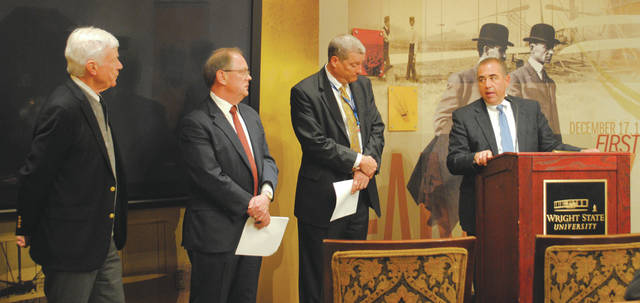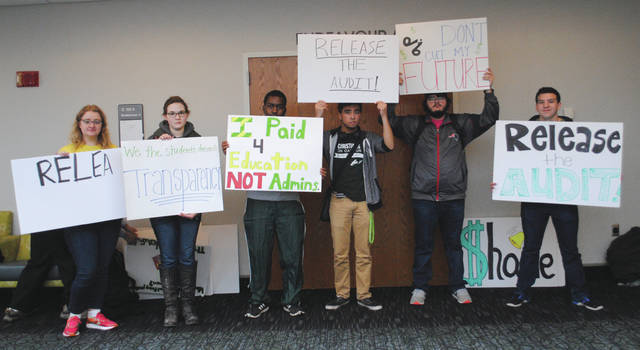

FAIRBORN — Wright State University is aiming for more transparency regarding its financial matters. It released a Plante Moran report April 7, which reviewed financial details from 2011 through 2015 concerning practices by the Wright State Research Institute and Wright State Applied Research Corporation.
“The board made this report available to help reassure the public that we are transparent in our work,” WSU Board of Trustees Chairman Michael Bridges said. “Perspective is vital, this study captures just a snapshot in time when the Plante Moran [report] was done.”
The WSARC is a non-profit corporation which acts as the administrative entity for the WSRI and Wright State.
The Plante Moran audit report highlighted issues in the university’s H-1B Visa process, personnel and hiring procedures, grant reporting and contracts, WSARC unrecoverable funds, conflicts of interest relating to individuals and entity contracts, operational inefficiencies and defective internal compliance and control.
H-1B Visa process
After Wright State learned of the federal investigation in 2015 concerning its H-1B Visa process, it undertook its own internal investigation. It found that visa workers employed by the university were being utilized at non-university establishments, reimbursing WSU for the work, which is possibly against the law, according to Wright State.
“The report showed that three people, especially, fell short of this university’s expectations of faculty and staff,” Bridges said. “Actions taken against them, because two of those individuals are teaching faculty, there’s a lengthy process to termination. The board today asked the administration to move forward and complete the appropriate processes.”
He added that the board has also asked that the school seek to recover funds from the individuals “at the center of the investigation” spent by the university on the H-1B Visa federal examination. Wright State Board of Trustee officials said the university has been as compliant as possible with the ongoing H-1B Visa federal investigation, with no end in sight.
“The H-1B program has been reviewed, changes have been made and future handling will be in-compliance with local, state and federal regulations,” Bridges said.
Personnel and hiring procedures
Personnel processes were bypassed for “less than a dozen positions,” allowing individuals to be hired at the WSRI without the heavier hiring process put in place by Wright State.
WSRI Executive Director and WSARC CEO Dennis Andersh said it has since worked toward becoming more compliant with human resources policies set forth by Wright State.
Grant reporting and contracts
The report uncovered poor documentation on some grants and contracts.
WSARC unrecoverable funds
In some cases, the WSARC undercharged fees, ultimately that were less than the amount approved by the Defense Contract Audit Agency.
“WSARC and WSRI are paying for themselves now,” Bridges said.
Andersh said the entities owed Wright State more than $4 million when the financial matters started to get sorted, but that debt is now slightly more than $1 million.
Conflicts of interest
Minor conflicts of interests existed at some points between contract agencies and individuals.
Operational inefficiencies
As a result of operational inefficiencies, there was a decreased chance of full reimbursement to Wright State on some projects.
“We’ve made significant cuts to reduce the cost of operation and improve the effectiveness on the ways we do business,” Andersh said, adding that 40 positions were eliminated, while some were to the university, ultimately cutting its operational budget by 41 percent.
In some cases, Andersh said duties had to be split or responsibilities had to be redefined.
Below-par internal compliance and control
Andersh said it has implemented a checks-and-balances system within the WSRI to ensure trust between itself and the university, as well as establishing a standard operating procedure. Its checks-and-balances system started with separating contracting and finance functions within the entities, which Andersh said is how it should have been all along.
He added that the entities have overhauled its former board of directors, aiming for more transparency. Andersh said it has worked toward this by welcoming a member to its board of directors who also belongs to the WSU board of trustees, in addition to rewriting operational procedures and ensuring it is following all regulations.
“The problems were that WSRI and WSARC were set up with inadequate funding and were operated under a culture that coveted winning research grants at almost any cost,” WSU Board of Trustees Vice Chairman Doug Fecher said. ” … The poor execution included a lack of internal controls, lack of oversight and it did not have transparency to the rest of the university community, including to a large extent, to the board of trustees as its membership has evolved over time.”
Solutions
University officials said they are currently focused on rebuilding trust with communities and that the problems highlighted on the report are now old issues, which have already been resolved. They said over the last few months they have worked toward meeting the recommendations revealed by the report.
Those steps include improving its compliance by hiring a director of research compliance; expanding its legal team; changing oversight duties between the provost and the president, with the provost now focusing on academic oversight and the president keeping track of operational oversight responsibilities; undertaking new uniform contract review processes for purchasing and utilizing the Dinsmore and Shohl law firm to assess current H1-B Visas and review future hiring processes. Wright State is also a member of the Ohio Checkbook, allowing anyone to see its budget and purchases.
However, some Wright State pupils don’t feel that the issues have been resolved to their best interest. Students carrying signs demanding more transparency from university officials stood in the back of the room April 7 when this information was revealed during a press conference. They expressed dissatisfaction on the selected budget cuts made by Wright State.
“It’s getting to the point where I am literally afraid for my education,” Religion Major Adam Williams, 21, of Centerville said. “It’s getting to the point where I don’t know if I’ll be able to come here next semester … because … I cannot trust the people running this university with the money that comes in and out of here.”
“They don’t treat teachers right here,” Modern Language Major Bitsy Hiodenbrandt said. “They have adjuncts here who do a ridiculous amount of work for a piddly amount of pay. It’s not fair for a university — where we go to be educated — isn’t focused on that. They need to be treating their faculty and students the best they can and they simply aren’t with the classes they’re cutting and [amount] of faculty they’re cutting. It’s not fair to the faculty, their family or us students.”
“From what I understand, the Office of Disability Services was within budget but was asked to make cuts, the same as everyone else, but now they’re going to make the offerings for students with disabilities ‘pay to play’ basically, which is unconscionable,” English Major Helena Jenkins, 19, of Englewood said. ” … I can’t sit by and watch them take away money and offerings from students who really need it.”
University officials reaffirmed that delivering a quality education remains a top priority at Wright State. Additional cuts or combining some university capacities are possible in the future but will be examined in the coming months when a full budget becomes available.
“There’s been … a history within the last three to four years that our revenues have changed over time, either due to state support or changes to tuition and enrollment that we did nothing about [as far as] aligning the expenses at the time to the revenue,” Fecher said. “I’m happy to sit down with any student to explain how the finances work. In the end, we only have so many dollars that come in and we have to make sure we spend that or less.”
“Had we taken action three, four … years ago to better align our expenses with the revenue that was coming in, we wouldn’t be where we’re at,” Fecher added. “The cuts we have to make this year are cuts we should have made three, four, five years ago.”
Some cuts will take place at the very top. Interim Wright State University President Curtis McCray, Ph.D, simply said “yes” when asked if steps would be taken toward downsizing administration.
“We will definitely be reducing the amount of administrators across the top of the organization,” McCray said. “Could be 12, could be 20.”



